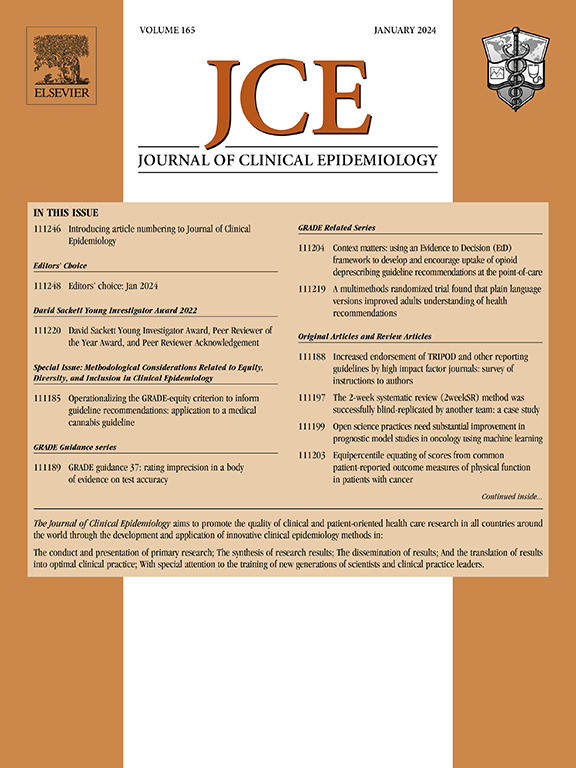Immortal time bias tends to be more pronounced in methodological studies than in empirical studies: a metaepidemiological study
IF 5.2
2区 医学
Q1 HEALTH CARE SCIENCES & SERVICES
引用次数: 0
Abstract
Objectives
Immortal Time Bias (ITB) is a critical challenge in observational studies estimating treatment effects, often addressed using Mantel–Byar (MB) and Landmark (LM) methods. However, the impact of ITB appears to differ between methodological and empirical studies. This study aims to investigate whether the ITB would be affected by study types and how.
Study Design and Setting
We systematically searched PubMed from January 1, 2010, to May 31, 2023, to identify empirical and methodological studies explicitly using LM or MB to address ITB. Eligible studies reported hazard ratio comparing: (i) unadjusted vs MB/LM-adjusted or (ii) MB vs LM-adjusted. We first examined estimate discrepancies across ITB-handling strategies within empirical or methodological studies, and then evaluated concordance across study types.
Results
We included 67 studies (46 empirical, 21 methodological). For unadjusted vs adjusted comparisons (58 empirical, 42 methodological), methodological studies exhibited higher rates of conclusion discordance (64.3% vs 32.8%, P = .004), and opposite effect directions (40.5% vs 15.5%, P = .010). For MB vs LM comparisons (20 empirical, 12 methodological), more frequent conclusion discordance was observed in methodological studies (41.7% vs 0%, P = .004), and other discrepancy metrics showed no significant differences between study types.
Conclusion
Our findings suggest that ITB tends to have a more pronounced impact in methodological studies, indicating that its influence may vary across different study settings. For methodological studies, it is important to clarify the critical ITB settings and the corresponding handling approaches. For empirical studies suspected of ITB, using rigorous handling strategies can enhance the robustness of treatment effect estimates.

不朽的时间偏差在方法学研究中比在实证研究中更为明显:一项元流行病学研究。
不朽时间偏差(ITB)是观察性研究中评估治疗效果的关键挑战,通常使用Mantel-Byar (MB)和Landmark (LM)方法来解决。然而,ITB的影响似乎在方法研究和实证研究之间有所不同。本研究旨在探讨是否会受到研究类型的影响,以及如何影响。研究设计和背景:我们系统地检索了2010年1月1日至2023年5月31日的PubMed,以确定明确使用LM或MB来解决ITB的实证和方法学研究。符合条件的研究报告了风险比比较:(i)未调整vs. MB/ lm调整,或(ii) MB vs. lm调整。我们首先在实证或方法学研究中检查了itb处理策略之间的估计差异,然后评估了研究类型之间的一致性。结果:我们纳入了67项研究(46项实证研究,21项方法学研究)。对于未调整和调整的比较(58个经验性比较,42个方法学比较),方法学研究显示出更高的结论不一致率(64.3%比32.8%,P=0.004),相反的影响方向(40.5%比15.5%,P=0.010)。对于MB和LM的比较(20个实证比较,12个方法学比较),方法学研究中观察到的结论不一致更频繁(41.7%比0%,P=0.004),其他差异指标在研究类型之间没有显著差异。结论:我们的研究结果表明,ITB在方法学研究中往往有更明显的影响,这表明它的影响可能在不同的研究环境中有所不同。对于方法学研究,重要的是要澄清关键的ITB设置和相应的处理方法。对于疑似ITB的实证研究,采用严格的处理策略可以增强治疗效果估计的稳健性。
本文章由计算机程序翻译,如有差异,请以英文原文为准。
求助全文
约1分钟内获得全文
求助全文
来源期刊

Journal of Clinical Epidemiology
医学-公共卫生、环境卫生与职业卫生
CiteScore
12.00
自引率
6.90%
发文量
320
审稿时长
44 days
期刊介绍:
The Journal of Clinical Epidemiology strives to enhance the quality of clinical and patient-oriented healthcare research by advancing and applying innovative methods in conducting, presenting, synthesizing, disseminating, and translating research results into optimal clinical practice. Special emphasis is placed on training new generations of scientists and clinical practice leaders.
 求助内容:
求助内容: 应助结果提醒方式:
应助结果提醒方式:


